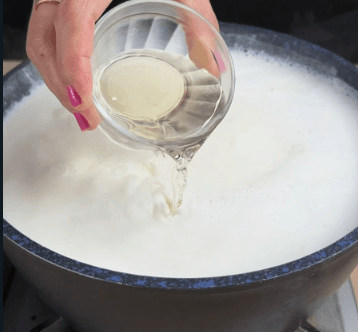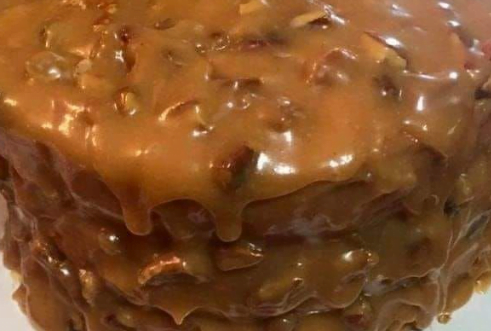Making cheese at home can be a rewarding and enjoyable experience. This simple homemade cheese recipe requires only a few ingredients and steps to create a delicious, fresh cheese that you can use in a variety of dishes.
Ingredients:
- 1 gallon (4 liters) whole milk
- 1/4 cup (60 ml) white vinegar or lemon juice
- 1 teaspoon salt (optional)
- Herbs or spices of your choice (optional)
Instructions:
Step 1: Prepare the Milk
- Heat the Milk:
- Pour the milk into a large pot and place it on the stove over medium heat.
- Slowly heat the milk to about 185°F (85°C). Stir occasionally to prevent the milk from scorching at the bottom of the pot.
Step 2: Add the Acid
- Add Vinegar or Lemon Juice:
- Once the milk reaches the desired temperature, slowly add the white vinegar or lemon juice while gently stirring.
- Continue to stir slowly as the milk begins to curdle. This process separates the curds (solid) from the whey (liquid).
Step 3: Let the Curds Form
- Resting Time:
- Turn off the heat and let the pot sit undisturbed for about 10-15 minutes. During this time, the curds will fully form.
Step 4: Strain the Curds
- Strain the Mixture:
- Line a colander with cheesecloth and place it over a large bowl to catch the whey.
- Carefully pour the curds and whey into the colander. Allow the whey to drain off completely, leaving the curds in the cheesecloth.
Step 5: Season and Shape
- Season the Cheese:
- If desired, sprinkle salt over the curds and gently mix it in. You can also add herbs or spices at this stage to flavor your cheese.
- Gather the cheesecloth around the curds and gently squeeze out any remaining whey.
- Shape the Cheese:
- Shape the curds into a ball or press them into a mold if you want a more defined shape.
- Leave the cheese wrapped in the cheesecloth and place it in the refrigerator for a few hours to firm up.
Serving Suggestions:
- Fresh Cheese:
- Enjoy your fresh cheese as is, spread on toast, or crackers. It pairs well with fresh fruits and honey.
- Seasoned Cheese:
- Mix in chopped fresh herbs like chives, parsley, or dill before chilling to create a flavored cheese.
- Savory Dishes:
- Use your homemade cheese in salads, pasta dishes, or as a topping for pizzas and casseroles.
Tips:
- Choosing Milk:
- Whole milk is best for this recipe as it produces a richer cheese. Avoid ultra-pasteurized milk, as it may not curdle properly.
- Temperature Control:
- Use a food thermometer to monitor the milk temperature accurately. Overheating can affect the texture of your cheese.
- Acid Choice:
- Both white vinegar and lemon juice work well to curdle the milk. Lemon juice adds a slight citrus flavor, while vinegar is more neutral.
- Whey Usage:
- Don’t discard the whey. It can be used in smoothies, soups, or as a substitute for water in baking to add a protein boost.
- Cheesecloth:
- Make sure to use a fine cheesecloth to ensure all the whey drains out without losing any curds. If you don’t have cheesecloth, a clean dish towel can be a substitute.
Variations:
- Herb Cheese:
- Add fresh herbs like basil, rosemary, or thyme to the cheese for a burst of flavor. Chop the herbs finely and mix them in after straining the curds.
- Spicy Cheese:
- For a spicy twist, add crushed red pepper flakes or finely chopped jalapeños to the curds before shaping the cheese.
- Garlic Cheese:
- Mix in roasted garlic cloves for a savory and aromatic cheese. Simply roast a few garlic cloves, mash them, and stir them into the curds.
Troubleshooting:
- Curds Not Forming:
- Ensure the milk is heated to the correct temperature and that you’ve added enough acid. Sometimes, adding a bit more vinegar or lemon juice can help.
- Cheese Too Soft:
- If the cheese is too soft, it might need more time to drain. Allow it to sit in the cheesecloth for a longer period, or gently press out more whey.
- Bitter Taste:
- A bitter taste can result from overheating the milk or adding too much acid. Be precise with your measurements and monitor the milk’s temperature closely.
Making cheese at home is a simple and enjoyable process that results in a fresh and tasty product. With just a few ingredients and steps, you can create a versatile cheese that can be used in a variety of dishes. Experiment with different herbs and spices to create your unique flavors and enjoy the satisfaction of homemade cheese.
Storage:
Store your homemade cheese in an airtight container in the refrigerator. It’s best consumed within a week for the freshest taste. If you’ve made a large batch, consider freezing portions. Wrap the cheese tightly in plastic wrap and place it in a freezer-safe bag or container. Thaw it in the refrigerator before use.
Making cheese at home is not only rewarding but also allows you to control the ingredients and flavors. This simple recipe is a great starting point, and once you get the hang of it, you can explore more complex cheese-making techniques. Enjoy your homemade cheese with a variety of dishes and share it with friends and family. Happy cheese-making!






